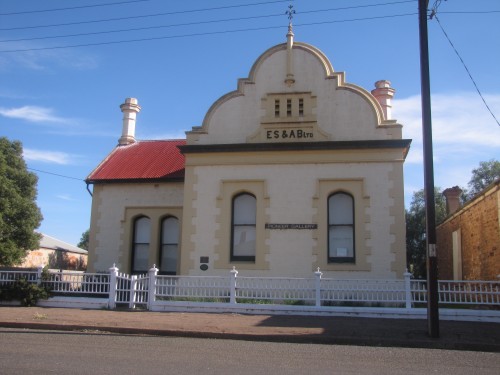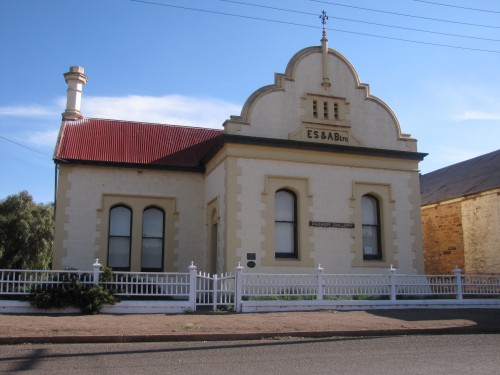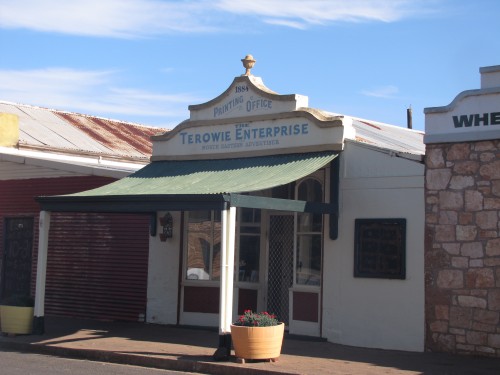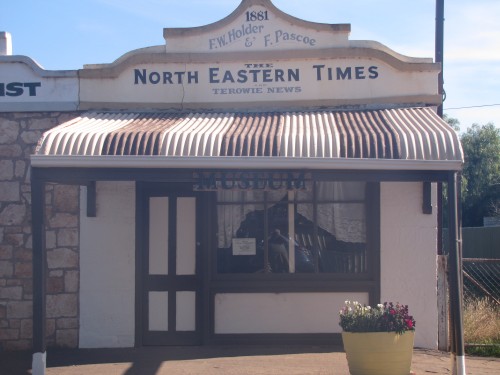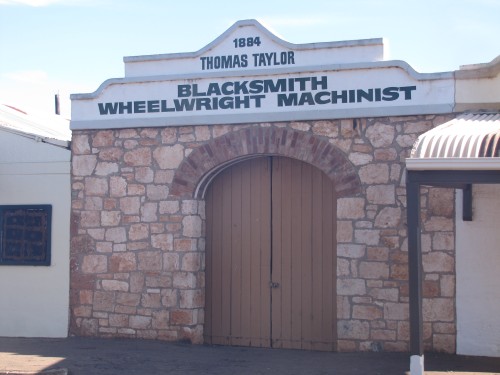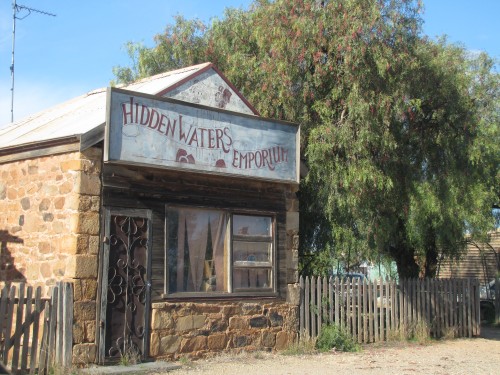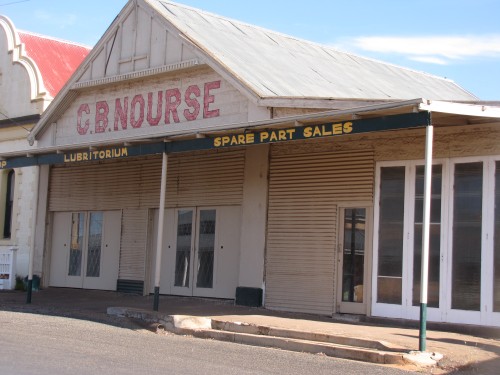E S and A Bank Terowie South Australia
On a recent visit to Terowie in the mid-north of South Australia I took several photos of the old E.S. & A. Bank in the main street. This old building was built in 1884 in the heyday of this important historic, rural town. The 1880s saw this town boom in size due mainly to the rapidly expanding agriculture in the region as well as the establishment of the railway lines serving this area.
The photo below shows the bank in 1909. The photo appears on the State Library of South Australia Terowie collection which shows many historic photos of the town (click here to view).

The building today is used as a Pioneer Gallery.
As an interesting aside I was not aware of the meaning of the letters in the name of the bank until I did some research. E.S. & A. Bank’s full title was the English Scottish and Australian Bank. There were many branches in Australia in earlier times. The first was opened in 1853 in Sydney. The bank merged with the Australia and New Zealand Bank (ANZ) in 1970 to become the Australia and New Zealand Banking Group.
Over the last week or so I have shared more articles and photos of Terowie. Look back through my posts to read them, or go to the archives link above.
Newspapers in Terowie South Australia
On a recent visit to Terowie in the mid-north of South Australia I took the two photos shown on today’s post. They show the two newspaper buildings of the town, both established in the 1880s. The two newspaper buildings are separated only by the local blacksmith building which a featured here a few days ago.
When I look at Terowie today I find it very interesting that this town, now something of a backwater – was so vibrant that it needed two newspapers. (I should add that subsequent research has indicted that the two newspapers probably did not publish concurrently.)
The town’s population once reached 700 and served a vast agricultural region. Today only about 200 people live in the town and district and many factors have seen its decline. It is no longer a railway centre and farming has proved to be marginal at best, even in good years of rainfall.
The Terowie Enterprise must have been an interesting newspaper. You can read about it here and below I have included a quote from the paper.
During Joseph Pengelley’s ownership there was much discussion about “moral” issues. An 1887 editorial titled “Base immorality” used the strongest terms to attack a family involved with the “seduction” of a young girl at Petersburg (7 October 1887, p.2). Pengelley also wrote articles against alcohol, gambling, and church interference in politics.
If you look closely at the photo below of the North Eastern Times newspaper building it now has a ‘museum’ sign in the window. Next time I am in the area I must take more time to explore the town more, including visiting the museum.
Further reading:
- South Australian History – Terowie – a comprehensive coverage of the history of the town
- The Terowie Enterprise – details about the newspaper, including a facsimile of a page from the paper (which I cannot publish here due to copyright).
The old blacksmith in Terowie South Australia
In the 1880s through to the early 1900s the township of Terowie in the mid-north of South Australia was a bustling place of activity. The town was an important railway centre for many years as the state thrived and expanded. The town also served a growing farming community there and further afield. Consequently, the town blacksmith opened in 1884 and operated by one Thomas Taylor, was an important business in the district.
I find it interesting that the building has been maintained and obviously restored to something of its former state. It shows a certain, commendable level of care and pride on the part of the current owners – or perhaps the community which desires to preserve the interesting history and heritage of the town. One source I found states that the blacksmith building is now a museum. It was closed when we went through recently.
One interesting and significant element of the town’s history occurred during World War 2:
Terowie became a large military camp in 1941 -1946. In March 1942 General Douglas MacArthur gave his first Australian press interview in Terowie after leaving the Philippines. His most famous statement was “I came out of Bataan and I shall return”.
Further reading:
- South Australian History – Terowie
- South Australian Tourism site
- The historic town of Terowie
- Terowie – from the website of The Age newspaper – much information about the buildings and sights of the town.
- Historic photos of Terowie – an extensive collection of photos of Terowie
The photo below shows the interior of the blacksmith in its heyday in 1909:

Hidden Waters Emporium, Terowie
In recent days I have been posting photos of some of the old buildings in the historic town of Terowie. Terowie is in the mid-north of South Australia between Peterborough and Burra and north-east of the Clare Valley. In its heyday it was a bustling railway town and an important service centre for the surrounding rural properties. These days it is a sleepy residential backwater with only a handful of the former businesses still operating.
On our recent drive through the town – one needs to take a detour off the main highway – I took the photo above of the Hidden Waters Emporium. I always smile when I see such a modest building have the title of “emporium”. The word for me conjures up images of very large stores selling a large variety of items, a bit like our department stores of today. It speaks to me of grandiose structures, not tiny buildings like the one shown in the photo above.
The definition of the word can vary depending on which dictionary you consult. Some define it along the lines I have described, while others are content to leave it at describing any store which sells a variety of items. I know nothing of the history of this particular “emporium” except that there are several references online to it being a second-hand shop in the past. One of those references is here in the National Library of Australia. The entry there shows a photo of the shop in operation as a second-hand outlet.
Sadly, this fascinating building seems to be well past its prime and is only used as a storage place for some junk.
Update: Since writing this article I have discovered where the “Hidden Waters” name is derived.
Terowie, whose name is derived from a local Aboriginal word meaning ‘hidden water’ was originally a watering pause on a stock route from the north-east of South Australia.
Terowie Lubritorium, South Australia
Terowie is an historic town in the mid-north of South Australia, between Burra and Peterborough. We paid a short visit to the town recently after visiting family in Peterborough. One of the old buildings which caught my attention is shown in the photo above.
I can’t find any reference to who C.B. Nourse was, but in the heyday of the town when it was a thriving service centre for the surrounding rural district, this business must have also done very well.
Times change and the town is now a quiet backwater, with very few businesses still open. Many old buildings have been abandoned and are deteriorating and the population has dwindled.
The wording on the fascia board is of interest to me. A “lubritorium” is obviously an establishment where motor vehicles are lubricated, maintained and repaired. While the term is in common use in the United States it is less so these days in Australia, though I seem to remember when growing up in the 1950s that it was far more widespread in usage here in Australia too. These days we tend to use “service centre” or even “garage” instead.
